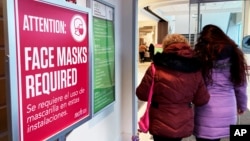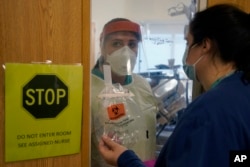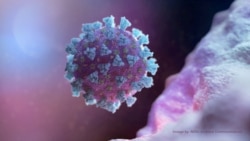The number of people entering the hospital with COVID-19 has increased in the United States since early July. The increase is similar to the past three summers but with far fewer cases than before.
With an updated vaccine still months away, experts worry this summer’s increase in hospitalizations could become a bigger problem.
How bad is the increase?
For the week ending July 29, COVID-19 hospital admissions were at 9,056. That is an increase of about 12 percent from the week before. But it is a lot less than the former high points. For example, there were 44,000 weekly hospital admissions in early January, nearly 45,000 in late July 2022, and 150,000 when the Omicron subvariant spread in January 2022.
Dr. David Dowdy is an infectious disease expert at Johns Hopkins Bloomberg School of Public Health. He said it is increasing a little, but it is not something to be overly concerned about.
It is likely that infections are rising too, but data is lacking. Federal officials ended the public health emergency in May. That means that the Centers for Disease Control and Prevention (CDC) and many states no longer follow the number of positive test results.
Since early June, about 500 to 600 people have died each week. The number of deaths appears to be unchanging this summer. But past increases in deaths usually follow behind hospitalizations.
How are we following the virus?
The amount of the COVID-19 virus in wastewater has been rising since late June across the U.S. In the coming weeks, health officials say they will look closely at wastewater levels. People will be returning from summer travel and students will be going back to school then.
Cristin Young is an infectious disease expert at Biobot Analytics. The CDC uses Biobot Analytics to study wastewater. She said researchers are finding higher levels of COVID-19 in wastewater in the Northeast and South.
“It’s important to remember right now the concentrations are still fairly low,” Young said. She noted that it is about 2.5 times lower than last summer.
There is not one kind of variant that appears much more than others. But there is a higher number of cases from one kind of Omicron variant – EG.5. Some are calling this variant “eris” but scientists are not using that name.
“There are a couple that we’re watching, but we’re not seeing anything like Delta or Omicron,” Young said, talking about former variants that caused high increases in COVID cases. And genetic changes to the virus that happen naturally do not necessarily make it more dangerous.
“Just because we have a new subvariant doesn’t mean that we are destined to have an increase in bad outcomes,” Dowdy said.
When is the new vaccine coming?
This autumn, officials expect to see updated COVID-19 vaccines that contain the Omicron variant XBB.1.5. It is an important change from today’s combination shots. They mix the original coronavirus with last year’s most common Omicron variants.
It is not clear when people can expect what officials hope is a yearly COVID-19 vaccine in autumn. Drug makers Pfizer, Moderna and Novavax are all creating vaccines with the XBB update. But the Food and Drug Administration will have to approve the shots. And the CDC must then issue suggestions on their use.
Dr. Mandy Cohen is the new CDC director. She said she expects people will get their COVID-19 vaccines where they get their vaccines for another infectious disease, the flu. She expects people will get vaccines at places like work or drug stores, rather than places that were set up just for COVID-19 vaccinations. Those places were set up early in the pandemic as part of the emergency measure.
“This is going to be our first fall and winter season coming out of the public health emergency, and I think we are all recognizing that we are living with COVID, flu, and RSV,” Cohen told The Associated Press last week. Respiratory Syncytial Virus, or RSV, is another infectious disease. “But the good news is we have more tools than ever before.”
I’m Caty Weaver. And I’m Gregory Stachel.
Carla K. Johnson reported this story for The Associated Press. Gregory Stachel adapted it for VOA Learning English.
________________________________________________
Words in This Story
update – v. to make (something) more modern
admission – n. the act or process of accepting a patient in a hospital for treatment
positive – adj. showing the presence of a particular germ, condition, or substance
concentration – n. the amount of an ingredient in a mixture
destined – adj. certain to do or to be something
original – adj. happening or existing first or at the beginning
fall – n. autumn
___________________________________________________
What do you think of this story?
We want to hear from you. We have a new comment system. Here is how it works:
- Write your comment in the box.
- Under the box, you can see four images for social media accounts. They are for Disqus, Facebook, Twitter and Google.
- Click on one image and a box appears. Enter the login for your social media account. Or you may create one on the Disqus system. It is the blue circle with “D” on it. It is free.
Each time you return to comment on the Learning English site, you can use your account and see your comments and replies to them. Our comment policy is here.












Forum